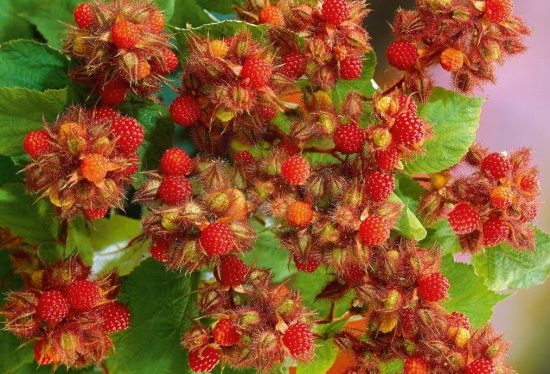For our country, Japanese raspberry is still a rare and exotic plant. She comes from China, Korea and of course Japan. It was brought to Europe as an ornamental plant.
Japanese raspberries turned out to be so unpretentious that they easily took root not only in gardens and plantations, but also in the wild. In North America, it can often be found in forests, on mountain slopes, and just along roads.
Japanese raspberries are very similar to our regular raspberries. It has a perennial root system and biennial stems. In the first year, the young shoot grows quickly and reaches a length of up to 3 meters. In the second year he growsseveral side shoots on which racemose inflorescences appear.
Flowering begins at the end of spring. Flowers appear on short and very bristly tassels. Each flower is 6-10 mm in diameter, has five purplish-red petals and bristly calyxes. The berries ripen in late summer. They are about 1 cm in diameter, orange or red in color.
Japanese raspberries are propagated by both seeds and layering. The stem, bent and lightly sprinkled with soil, takes root easily. Growing this overseas guest is not difficult at all. The agricultural technology is the same as for growing conventional raspberry varieties.
It tolerates frosty winters well and can grow in well-lit areas and in the shade. Prefers moist soil, but easily tolerates drought.
Ripe berries have a sweet and slightly tart taste. Perhaps because of this astringency, Japanese raspberries are widely used in winemaking. In some areas it is even called wineberry. In cooking, Japanese raspberries are used in the same way as regular raspberries. It is used to make jam, compotes, bake pies and other sweets.
It is also worth noting that Japanese raspberry is also of interest as an ornamental plant. Its shoots are completely covered with thin bristles that are not at all prickly. The leaves are emerald green on top. And the bottom is silvery, as if velvet. This bush looks very impressive during flowering and fruiting.
But the main charm of this plant lies in the combination of its high decorative qualities with no less high taste qualities. Gardeners who managed to acquire this exotic wonder do not regret it at all.
If you are interested in rare and unusual varieties of raspberries, then you may be interested in reading about how to grow Black raspberries on your property. The article is called Black raspberry planting and care
YOU CAN ALSO READ:
How to remove raspberries from the garden
Planting remontant raspberries




 (4 ratings, average: 3,75 out of 5)
(4 ratings, average: 3,75 out of 5) CUCUMBERS NEVER GET SICK, I'VE BEEN USING ONLY THIS FOR 40 YEARS! I SHARE A SECRET WITH YOU, CUCUMBERS ARE LIKE THE PICTURE!
CUCUMBERS NEVER GET SICK, I'VE BEEN USING ONLY THIS FOR 40 YEARS! I SHARE A SECRET WITH YOU, CUCUMBERS ARE LIKE THE PICTURE! You can dig a bucket of potatoes from each bush. Do you think these are fairy tales? Watch the video
You can dig a bucket of potatoes from each bush. Do you think these are fairy tales? Watch the video
 How our fellow gardeners work in Korea. There is a lot to learn and just fun to watch.
How our fellow gardeners work in Korea. There is a lot to learn and just fun to watch. Eye trainer. The author claims that with daily viewing, vision is restored. They don't charge money for views.
Eye trainer. The author claims that with daily viewing, vision is restored. They don't charge money for views. A 3-ingredient cake recipe in 30 minutes is better than Napoleon. Simple and very tasty.
A 3-ingredient cake recipe in 30 minutes is better than Napoleon. Simple and very tasty. Therapeutic exercises for cervical osteochondrosis. A complete set of exercises.
Therapeutic exercises for cervical osteochondrosis. A complete set of exercises. Which indoor plants match your zodiac sign?
Which indoor plants match your zodiac sign? What about them? Excursion to German dachas.
What about them? Excursion to German dachas.
In fact, this Japanese raspberry is a very beautiful plant. And delicious!